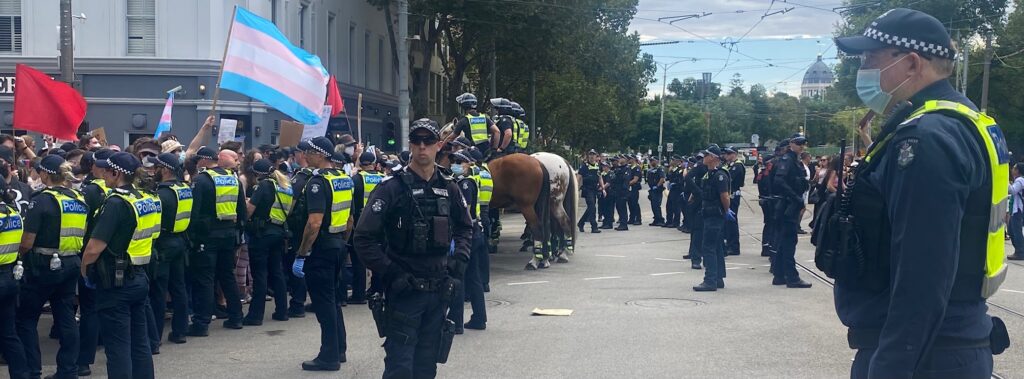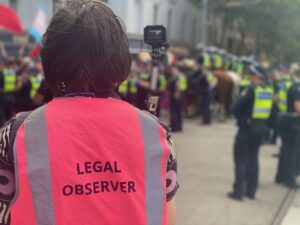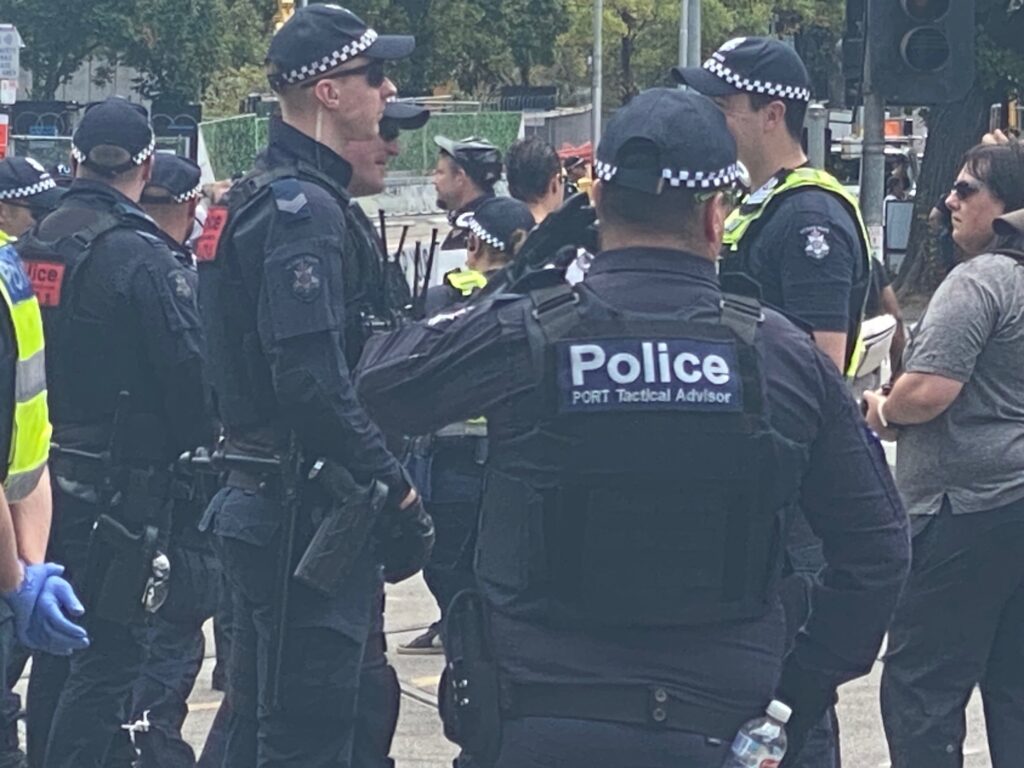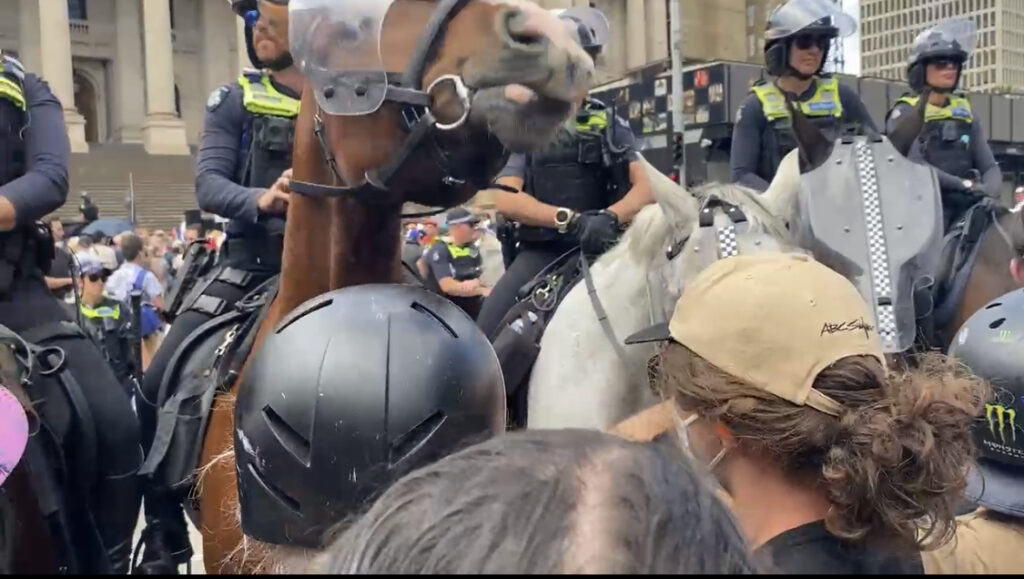Statement of Concern: Policing of opposing anti-trans & trans rights rallies
Parliament House, Melbourne, Saturday, 18 March 2023

Melbourne Activist Legal Support (MALS) expresses concern regarding the failure of police to act compatibly with human rights and give proper consideration to human rights in tactical decisions whilst policing opposing rallies at Parliament House on Saturday, 18 March 2023.
MALS asserts that Victoria Police failed to consider or uphold any of its numerous obligations to prevent discriminatory or prejudice-motivated acts towards trans and gender-diverse people in its policing of the rallies on Saturday afternoon. In fact, MALS observed that the policing itself constituted biased and discriminatory actions on the part of Victoria Police.
MALS also raises several specific areas of concern around the misuse of oleoresin capsicum spray (OC spray), incidents of excessive force, and mistreatment of legal observers. These are detailed below.
Background
On Saturday, 18 March 2023, Melbourne Activist Legal Support (MALS) fielded a team of seven trained Legal Observers at the opposing rallies on Spring and Bourke Streets outside Parliament House in Melbourne, Victoria. Legal observers were present from 10:30am until 3:00pm, monitoring and recording the actions of Victoria Police.

British anti-trans rights campaigner Kellie-Jay Keen Minshull (also known as Posie Parker) led a speaking event on the steps of Parliament House. Groups associated with the anti-lockdown or ‘Freedom Movement’ and far-right groups attended in support of the Kellie-Jay Keen Minshull event.
Two separate groups of trans rights protestors had mobilised to counter-protest the Kellie-Jay Keen Minshull event. One large group of approximately 200-300 people were mobilised by Campaign Against Racism & Fascism (CARF) and the National Union of Students Queer Department (NUS) at Carlton Gardens at 11:00am and marched to the Parliament House area at 11:40am. A second large group of trans rights protestors from Trans Queer Solidarity Naarm gathered at the Parliament steps at 11:00am until they were moved to the south side of Bourke Street by police at approximately 11:15am.
MALS fielded legal observers at both mobilisation points and throughout the Parliament precinct.
AREAS OF CONCERN
1. Biased and discriminatory approach to crowd management
Multiple tactical decisions made by Victoria Police forward commanders throughout the day failed to consider a range of human rights and legal obligations.
Police on the day stated that their primary intention was to prevent contact between the opposing groups, and they made efforts to prevent the opposing groups of demonstrators from coming into contact with each other using physical cordons. However, legal observers noted clear differences in the tactics and approaches police used toward the two opposing groups. Police Commanders and Public Order Response Team (PORT) Tactical Advisors concentrated crowd control measures almost exclusively on the assembled trans rights groups. This included close-quarter physical police cordons that increased the risk of police contact and use of force incidents arising for one group only (see below). The Trans Queer Solidarity Naarm group was immediately cordoned by police from their arrival at 11.00am until they dispersed after 3.00pm
Policing decisions to target resources and crowd control measures toward only one of the opposing rallies increased risks and harm for one group while effectively facilitating the open display of hate speech against trans and gender-diverse people by the other group. It is MALS’ view that the vastly different approaches to the two opposing groups and the resulting harms, arrests, use of force, and the failure to act upon any of the hate-motivated messages and behaviour on display formed a clear pattern of biased and discriminatory policing.
– Policing of neo-Nazi group
At 11:40am, just prior to the CARF/NUS group arriving at the Parliament precinct, a group of approximately 20 people known to be members of the neo-Nazi National Socialist Network (NSN) had been permitted by police to enter Spring Street and made a formation facing north across the street, making a series of ‘Sieg Heil’ hand salutes and holding up a threatening and offensive banner. MALS has observed that chants of “kill paedo freaks” were simultaneously being yelled at the trans rights protestors. These actions were clearly intended to provoke and incite the group of arriving trans rights protesters. MALS did not observe any attempts by police to prevent, intervene in, or restrict the actions of this group.
Police instead focused their attention on the CARF/NUS group and established a cordon with multiple police members and the mounted unit facing them. It was at 12.03pm that the first use of OC spray was observed (see below).
At approximately 12:17pm the neo-Nazi NSN group moved in formation up the Parliament House steps to stand in a highly visible and central location on the steps and continued to make ‘Sieg Heil’ salutes.
At 12:49pm, over an hour after they had first arrived, police arranged to escort the NSN group away from Parliament House, moving south along Spring St. However, in doing so, they allowed the group to march towards and along the perimeter of the trans rights protestors, while still making ‘Sieg Heil’ salutes and chanting obscenities at the trans rights group. This decision to escort the group towards and directly in front of the trans rights protestors predictably increased tensions and aggravated protestors. Legal observers noted multiple uses of force, including excessive force incidents against trans rights protesters directly related to this decision. OC spray was used at trans rights protesters again at this point (see below).
– Legal & human rights considerations
Police were not powerless to act against the displays of hate-motivated speech or behaviour in the context of Saturday’s protests. In fact, they had obligations to act.
Victoria Police have obligations under the Charter of Human Rights and Responsibilities Act (2006) to protect the rights to peaceful assembly and freedom of association (Section 16), as well as obligations to uphold Article 21 of the International Covenant of Civil & Political Rights (ICCPR). Importantly, both assemblies and counter-demonstrations (when one assembly takes place to express opposition to another) fall within the scope of the protection of Article 21. Police must, in principle, take a content-neutral approach to counter-demonstrations and these approaches must not be based on the identity of the participants or their relationship with the authorities. The recognition of the right of peaceful assembly imposes an obligation on police to respect and ensure its exercise without discrimination (see UNHRC General comment No. 37 (2020) on the right of peaceful assembly (paragraphs 8,-9, 21, 25-26).
Victoria Police commonly place cordons and restrict opposing groups from making direct physical contact when policing opposing assemblies. However, in doing so, police must ensure that their tactics and operational measures do not result in discrimination in the enjoyment of the right of peaceful assembly, for example, on the basis of race, colour, ethnicity, age, sex, language, property, religion or belief, political or other opinion, national or social origin, disability, sexual orientation or gender identity, or other status. (UNHRC General comment No. 37 (2020) paragraph 25).
Particular efforts must be made to ensure the equal and effective facilitation and protection of the right of peaceful assembly of individuals who are members of groups that are or have been subjected to discrimination or that may face particular challenges in participating in assemblies (UNHRC General comment No. 37 (2020) paragraph 25).
Generally, human rights jurisprudence accepts that the use of flags, uniforms, signs, and banners is to be regarded as a legitimate form of expression that should not be restricted, even if such symbols are reminders of a painful past. However, in cases where such symbols are directly and predominantly associated with incitement to discrimination, hostility or violence, appropriate restrictions should apply.[i]

Victoria prohibits discrimination based on sexual orientation and gender identity under the Equal Opportunity (Gender Identity and Sexual Orientation) Act 2000.
Numerous Victorian Acts, including the Racial and Religious Tolerance Act 2001, Crimes Act 1958 and the Summary Offences Act 1966, include general obligations to act to prevent prejudice-motivated crimes. Victoria Police define prejudice-motivated crime as any crime motivated by bias or hatred towards a person or a group. Despite no specific anti-vilification laws being available MALS believes that police failed to consider any of these obligations or existing protections against discrimination, nor their powers to act to prevent breaches of the peace, during their operations on Saturday, 18 March.
– Summary
MALS has found that Victoria Police Forward Commanders and PORT Tactical Advisors made explicit decisions on Saturday, 18 March, including:
- not intervening in or preventing highly distressing, provocative, prejudice-motivated behaviours and messaging by anti-trans, neo-Nazi groups and individuals;
- failing to consider the effect of the presence of known neo-Nazi groups and their provocative hate speech and behaviours upon crowd dynamics, or the need to consider existing state and federal anti-discrimination protections in their response to these groups;
- allowing and facilitating the free movement of neo-Nazi groups within highly visible, prominent, and central positions within the protest area and directly in front of opposing counter-protesters;
- concentrating police resources and cordons almost exclusively toward trans rights protest groups, increasing the likelihood of these groups experiencing direct police-protestor contact and use of force, and;
- deploying the use of force, including punches, grabs, pushes, horses, and OC spray against trans rights protesters in ways likely to substantially increase stress and tension, escalating the likelihood of arrests.
It is the view of MALS that this set of decisions, in the context of police obligations to consider human rights and non-discriminatory approaches to the policing of assemblies, demonstrated a clear pattern of bias and discrimination on the part of Victoria Police.
2. Excessive use of force
Legal observers witnessed and recorded multiple instances of police grabbing, shoving, hitting, and using offensive language towards protestors.
Multiple police use of force incidents appeared to legal observers to be forceful, intimidating and dangerous.
At 2:07pm on Bourke Street, MALS recorded footage of a PORT officer kneeing a protestor in the back of the neck twice after they had already been taken to the ground and were being held down by three other PORT officers.
MALS has also seen footage of a PORT officer stepping forward and punching a protestor in the face.
Legal observers also witnessed police officers grabbing and shoving protest marshals (identified in hi-vis vests) and, at times, appeared to be singling marshals out from the crowd.
3. Dangerous containment
MALS is deeply concerned by Victoria Police’s tactical decision to forcefully contain a remaining group of approximately 70-100 trans rights protestors near the conclusion of the rallies at 2:05pm.
In an apparent attempt to clear protest groups from the road, police used a concentrated surge to push a large group back towards the sidewalk on Bourke Street. While the trans rights protestors were not kettled (confined to an area they could not leave), the containment moved protestors back towards a tram stop with steps and railings, and into street gutters and building walls, limiting their area of movement and exit pathways.
Legal observers saw police pushing and grabbing protestors around the head and neck whilst shouting “move, move” and pushing them further back towards the building walls.
MALS observed that this overly forceful crowd control measure was unnecessary under the circumstances and served to ignite a series of events that culminated in two aggressive arrests, OC spray use, and injuries.
MALS has often observed similar Victoria Police decisions to kettle, push, or contain protestors. Police tactical decisions at protests can have significant and negative consequences, and increase the likelihood of conflict or arrests. This tactic can unnecessarily generate fear, stress, and tensions and create unnecessary risks to safety.
See: https://mals.au/2020/12/16/what-is-kettling/
4. Improper use of OC spray
Legal observers recorded multiple instances of OC spray use by police to force compliance or to force protestors to move.
According to the Victoria Police Manual, police officers are permitted to use OC spray only in response to violence or a serious physical threat to people’s safety.
Legal observers recorded police spraying people directly in the face after they had been taken down to the ground or were already being held by multiple officers. Legal observers also witnessed police using OC spray indiscriminately across a crowd of people, contrary to police guidelines. OC spray cannot be used against people who are being defiant or refusing to cooperate with police directives.
Legal observers obtained accounts from several people who had been hit with OC spray. They reported that the OC spray came unexpectedly (i.e.: not in response to any physical threats towards police) and without warning, and was deployed in broad, sweeping motions across the crowd.
Legal observers understand that around 25-30 people were treated for OC-related injuries by street medic teams. The attending paramedic team treated one person on-site.
5. Hindering of legal observers
On two separate occasions, legal observers were physically pushed by police while attempting to record incidents. MALS has previously raised the issue of police mistreatment of legal observers with the Chief Commissioner of Victorian Police and the Victorian Human Rights Commissioner.
The MALS team was also prevented from making direct contact with the Forward Commander on-site to establish lines of communication. This inhibited the ability of the legal observer team to relay concerns directly to appropriate police members. Establishing a direct communication link with the officer in charge at protest events is essential element to human rights protection.
In one instance before the official start of the rallies, two legal observers crossed Spring Street to walk across the front of the Parliament House steps to speak to a group of Victoria Police congregating on the south side of the steps. Up to four marshals from the Kellie-Jay Keen Minshull rally approached and spoke aggressively to the two legal observers, physically bumping into and shouting at them. While one legal observer explained they were independent and not with the counter-protest, four Victoria police officers surrounded the two legal observers and forced them to move on to the centre of the road. The two legal observers’ attempts to speak to a Commander were rebuffed. After several minutes, a police officer in an Acting Forward Command position identified themselves to the legal observers.
The practice of independent scrutiny of police powers is recognised by the United Nations Human Rights Committee (UNHRC). The UNHRC describes monitoring as necessary for the exercise of the right to peaceful assembly, emphasising the duties of law enforcement officials to “[protect] journalists, monitors and observers” (UNHRC, 2020, General Comment No. 37).
The UNHRC has also stated that observers “may not be prohibited from, or unduly limited in exercising their functions…They must not face reprisals or other harassment” (UNHRC, 2020).
6. Use of mounted horses for crowd control
The Police Mounted Branch present at the event included nine horses used to create containment lines. On numerous occasions, police horses were stationed directly in front of protest lines allowing contact between the horse and members of the public.

One horse was observed as being particularly agitated, behaving erratically and, at one point, head-butting a protestor. Footage taken by MALS indicates that this horse remained in the line and continued to make dangerous contact with protesters as it flung its head up and down for well over 25 minutes. MALS contacted the Acting LGBTIQ+ Portfolio Manager on duty regarding concerns over the possible danger to protesters if it continued. Police took no observed action to remove the horse.
MALS has repeatedly stated that the deployment of horses for public protest events is unwarranted, dangerous for people and the horses, and unnecessarily intimidating.
7. LGBTIQ+ Liaison Officers
The Acting LGBTIQ+ Portfolio Manager identified themselves to the legal observer team near Carlton Gardens at 11.00am. They were dressed in civilian clothes with no name badge or identifying insignia. They indicated that their intention was to ensure safety, and they understood the police’s aim was to keep the two opposing groups apart. At this point, the legal observers expressed concern about the vulnerability of some protesters who are LGBTIQ+, especially trans and gender-diverse people, who may find the large police presence unsettling and difficult.
LGBTIQ+ Liaison Officers (LLOs) were present at the event and were aware of the controversial and potentially harmful context of the event. However, LLOs were either in plain clothes or indistinguishable from other Victoria Police officers. They were not wearing any rainbow flags or other insignia on their uniforms identifying their role. When asked by a legal observer why LLOs were not identifiable, they stated that protestors wanting to speak with an LLO could ask individual officers if they were an LLO.
In the context of displays of hatred towards trans and gender-diverse people and heavy and aggressive policing, the suggestion that people go to individual officers until they find an LLO is obviously unrealistic and shows an indifference both to the wellbeing of queer and trans protestors and to the facilitation of a meaningful on-the-ground relationship with LLOs.
___
ACTIONS AND RECOMMENDATIONS
In light of the above areas of concern, Melbourne Activist Legal Support calls upon all authorities to ensure the following:
- The Independent Broad-based Anti-Corruption Commission (IBAC) and the Victoria Equal Opportunity and Human Rights Commission (VEOHRC) investigate the operational decisions made on Saturday as to the extent they may have constituted bias and discrimination and what measures may be applied to prevent re-occurrence.
- Victoria Police consult with bodies such as VEOHRC to review its Victoria Police Manual (VPM) policies, police attendance at events and incidents, operational planning, and operation orders in relation to all large civil disobedience protest events in order to ensure that the rights to peaceful assembly, association and expression are not limited by operational tactics that demonstrate bias or allow or facilitate discrimination and aligned with the UNHRC General Comment No. 37 (2020).
- Victoria Police immediately restrict the Mounted Branch to ceremonial and patrol duties only, and specifically prohibit any use of police horses in public order or crowd control scenarios.
- Victoria Police provide clear directives to members and reinforce Operational Safety and Tactics Training (OSTT) regulations and training to prevent further unlawful use of OC aerosols against citizens involved in peaceful but non-compliant forms of protest activity.
- Victoria Police ensure that all LGBTIQ+ Liaison Officers are clearly identifiable to members of the public when attending events when their liaison functions are likely to be required.
- Victoria Police specifically include the role of civilian legal and human rights observers within the Victoria Police Manual Crowd Control Guidelines (VPMG) and for Forward Commanders to brief operational members of the requirement to ensure the safety and access of legal observers who may be present at protest events.
—
This Statement of Concern is a public document and is provided to media, Victoria Police Professional Standards Command (PSC), Independent Broad-based Anti-corruption Commission (IBAC), the Victorian Equal Opportunity and Human Rights Commission (VEOHRC), Government ministers, Members of Parliament, international human rights agencies and other agencies upon request.
For inquiries regarding this statement please contact: [email protected]
[i]OSCE and Venice Commission, Guidelines on Freedom of Peaceful Assembly, para. 152. See also European Court of Human Rights, Fáber v. Hungary (application No. 40721/08), judgment of 24 October 2012, paras. 56–58.